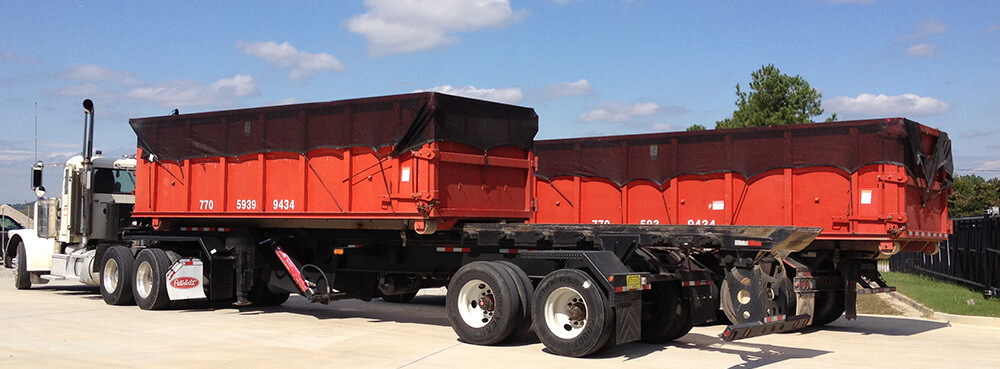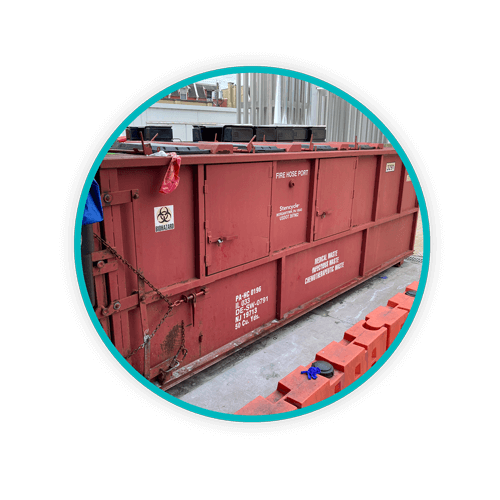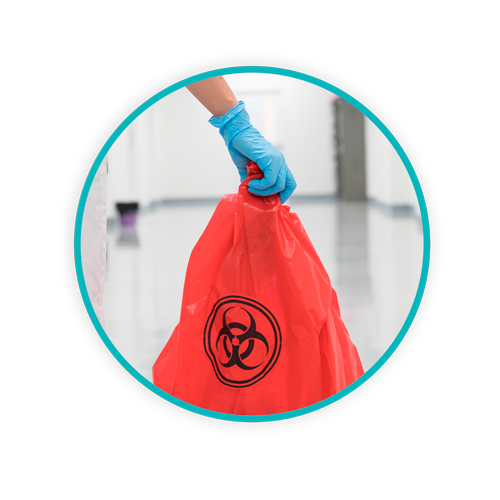The Trouble With Medical Waste Roll-Offs

Do you ever wonder what happens to all of that regulated medical waste after it leaves the patient room? Does it go straight to the treatment facility? Does it magically disappear? Does it go straight to landfill? (We certainly hope not)… If you are a facility that generates medium to large quantities of red bag waste, then you are no stranger to the challenges associated with segregation, disposal, and storage of these high-volume wastes.
Regulated Medical Waste (RMW) is the most common healthcare waste produced in US hospitals. In fact, each patient bed produces roughly 33lbs of medical waste per day, which makes up a total of nearly 6 million tons of medical waste produced in the United States on an annual basis. Once the waste is removed from patient areas, it is often brought down to the dock level for storage until it can be transported offsite to a treatment facility for final disposal. This poses a challenge for busy hospitals – where is all of this waste to be stored? With such large amounts of waste being generated on a daily basis, facilities require a large-scale solution for red bag waste storage in-between service and pickups. The most common solution today, offered by many medical waste disposal companies, is a one-size-fits-all mass disposal container known as a medical waste roll-off or RBX (Red Bag Box) container.
TOPICS WE WILL COVER:
1 / What is a Medical Waste Roll-Off?
2 / Medical Waste Roll-Off Compliance & Regulations
4 / EVS Labor Requirements & Risks
5 / The Daniels Health Solution
What is a medical waste roll-off?

An RBX Container / Medical Waste Roll-off is a large red, blue, or green dumpster that is rated for the disposal and storage of red bag waste. The approximate dimensions of a four-yard dumpster are 20 feet in length and eight feet in height and width, requiring at minimum the space of an entire dock bay. It is used to store red bag waste for varying periods of time, usually depending on your local regulations. It also contains a small front compartment which is rated for boxed chemotherapy waste storage. The trouble with medical waste roll-offs is that they come with a laundry list of risks that impact compliance, labor, infection control, safety, and security. Healthcare facilities are often unaware of these risks and do not know that a better solution exists.
Is your RBX container compliant?
OSHA and DOT regulations require the container to be entirely sealed, secure, and tamperproof. Being constructed with reinforced steel construction and commonly situated at a hospital loading dock completely exposed to the elements, it is not uncommon for RBX containers to be rusted in parts, exposing the waste within to unsealed access. Additionally, due to the needed efficiency of waste disposal at a hospital, lids are left open for quick “throw and run” disposal, breaching the OSHA and DOT requirements for sealed and secure containment and contradicting the requirements for waste to be located to minimize exposure to the public and being accessible only to authorized personnel.
The Department of Transportation has a list of compliance requirements delineating specific limitations for what type of waste is permitted in these containers, ranging from:
- Liquid volume limitations
- Restrictions against bulk outer packaging such as chest tubes, evacuated canisters, and disposable containers
Because of these requirements, red bag waste must be properly segregated prior to reaching the RBX container. In many cases, hospitals do not do this or are unaware of these regulations, thus risking compliance.
RMW Storage Regulations – The Good, The Bad, The Ugly
The internet holds little information on maintaining compliance with your medical waste roll-off, therefore it is important for a hospital to be familiar with its local waste storage regulations. In many states there are often no maximum time limits for the storage of RMW, however the waste must be maintained in a “nonputrescent state (using refrigeration when necessary), and vermin and insects must be controlled.” Where storage time limits exist, they range from seven days (NY) to 90 days (AZ). RBX containers are often found leaking blood and bodily fluids. Due to the fact that these RBX bins are stationary and located outside for extended periods of time, they are susceptible to erosion of the receptacle as well as rotting of the medical waste located inside. Since these dumpsters are often left sitting unattended for extended periods of time with no standard cleaning protocols in place, this creates increased infection control risks, specifically during warmer months. Untreated medical waste can often be found untethered on the ground next to roll-offs from misjudged disposal, bags tearing, or RBX overfill. Blood vials, broken ampules, and urine sample bottles have been found under catwalks leading to the dumping areas, all exposing patient health information (PHI) and posing a HIPPA violation risk. The combination of waste spillage and rainfall means that facilities are unintentionally sending contaminants down the storm drains and into the waterways.
exist, they range from seven days (NY) to 90 days (AZ). RBX containers are often found leaking blood and bodily fluids. Due to the fact that these RBX bins are stationary and located outside for extended periods of time, they are susceptible to erosion of the receptacle as well as rotting of the medical waste located inside. Since these dumpsters are often left sitting unattended for extended periods of time with no standard cleaning protocols in place, this creates increased infection control risks, specifically during warmer months. Untreated medical waste can often be found untethered on the ground next to roll-offs from misjudged disposal, bags tearing, or RBX overfill. Blood vials, broken ampules, and urine sample bottles have been found under catwalks leading to the dumping areas, all exposing patient health information (PHI) and posing a HIPPA violation risk. The combination of waste spillage and rainfall means that facilities are unintentionally sending contaminants down the storm drains and into the waterways.
Unlocked dump access doors can lead to waste tampering and even vermin infestations. Water intrusion from rain fall adds additional liquid and creates billable weight on each invoice. The bulk containers often become a backup for the municipal solid waste (MSW) compactor when frequencies between hauls became longer than anticipated, and stockpiling solid waste has to be disposed of. The RBX is often the place to put that waste stream at a much higher cost.
RISKS OF IMPROPER RMW DISPOSAL
EVS Labor Requirements & Risks
Safety
In order to dispose of waste in the RMW roll-off, the container must be positioned next to an elevated platform (often accessed via a scaffolded catwalk) to load red bag waste through a four-foot by four-foot opening, positioned roughly four feet away from the catwalk. This requires EVS to carry heavy bags full of bodily fluids and often improperly segregated sharps waste, posing major safety hazards and exposure to costly needlestick injuries. During inclement weather, waste disposal into the RBX/roll-off container cannot be fully completed by staff because snow accumulation on the catwalk ramp poses a slip hazard.
Multiple Touchpoints: Infection Control 
Medium to large quantity generators of medical waste often have as many as five touchpoints required from point of generation to final disposal of red bag waste. This is due to poor mapping of waste movement throughout the facility. The process of drip-feeding medical waste from point of generation into small kick buckets, into larger containers, and then into tip carts for transport to the final disposal within the roll-off increases labor requirements and exposes EVS staff and clinicians to cross-contamination risks. Does this traditional red bag waste process look familiar to you?
- Waste disposed at point of generation into kick bucket
- Red bag liner from kick bucket removed
- Red bags consolidated into larger bins in soiled utility rooms or patient areas while waiting to be transported
- Decanting of red bags into tip carts or linen carts for transport to dock
- Final disposal into medical waste roll-off
Dock Storage & Movement
At the dock level, a medical waste roll-off poses a myriad of issues. Taking up valuable dock space, the roll-offs are often left sitting unattended for extended periods of time with no standard cleaning protocols in place, creating increased infection control risks, especially during warmer months. Essentially, a dumpster full of rotting medical waste is an entirely avoidable circumstance, as a simpler and safer solution exists. Due to the height of the eight-foot roll-off, a ramp or elevated platform is required to access the top compartment for disposal. This ramp often takes up an additional space in the dock bay and is the cause of many injuries for anyone accessing the ramp during snowy or rainy weather. When the dock space does not allow for a ramp or elevated platform to be installed, the RBX unit must be filled from the side compartment and never reaches beyond 50% of its capacity before having to be pulled. Pull charges can range anywhere from $50-$200 per service, which can quickly add up for facilities generating medium to large quantities of red bag waste.
The Daniels Health Approach
Daniels Health core mission is to make healthcare waste management a safer and more efficient process for all involved. Daniels Health offers a solution that is so simple, you’ll wish you had thought of it sooner!
Through a comprehensive assessment of your current waste flow, we seek to identify opportunities to reduce required touches and decrease disposal requirements. Combined with smarter positioning of containers, container rightsizing, reusable RMW bins, and the introduction of Daniels unique on-site storage solutions, we are able to reduce medical waste labor requirements by up to 75%. In many hospitals Daniels Health partners with, we have replaced unsightly RBX containers with on-site trailers and smart storage solutions that can elevate medical waste bins to minimize ground contamination and house them in a weather-proof unit to ensure that the potential for exposure or unauthorized access is eliminated. Servicing hundreds of hospitals across the United States, we are no strangers to the unique nuances of each hospital facility and the challenges that come with waste management:
- Tight dock space with limited storage area
- Narrow corridors or service lifts shared by patients and hospital workers alike
- Loading docks co-shared by emergency services and hospital service vendors
- Convoluted pathways for waste movement between patient areas and the dock
Our team is dedicated to conducting a full site audit and developing a medical waste dock management plan that is designed to drive safety, labor, and cost efficiencies across every touchpoint of the waste journey. We will not only look at current waste storage to identify space and waste flow efficiencies that can be gained, but we will also examine how many times waste is touched before it reaches the loading dock to suggest solutions for minimizing touches and labor in the waste handling process.
What about the RBX?
In many hospital dock scenarios whereby a large storage unit is required to hold medical waste, the medical waste roll-off is replaced with a clean two-tier Daniels trailer. With the elimination of loose red bags, full and secured medical waste bins are wheeled directly onto the Daniels trailer situated at the hospital dock. Once the trailer is full, our drivers swap out the full trailer for a fresh trailer with clean medical waste bins that are ready to use. It’s that simple! In the instance where a large trailer is not required, we would allocated a secure caged area for the stroage of full sharps and RMW containers, segregated to achieve maximum compliance and kept safe in our mobile weather-resistant transporters.
As stated above, the best solution for one hospital dock is not going to be the same for another. This is where having operational, compliance, and clinical expertise helping you to navigate your unique requirements is always going to deliver the best outcome for staff safety, compliance, and labor costs. To speak to one of our hospital dock transformation experts, reach out to us here. Alternatively, explore the case study below of a recent hospital in the northeast that we transformed.
Let's Talk!
Your time is valuable, and we don’t want to play hard to get. You can either phone us directly on the details listed on our contact page, or feel free to fill out this short form and one of our team members will get back to you as quickly as possible.
